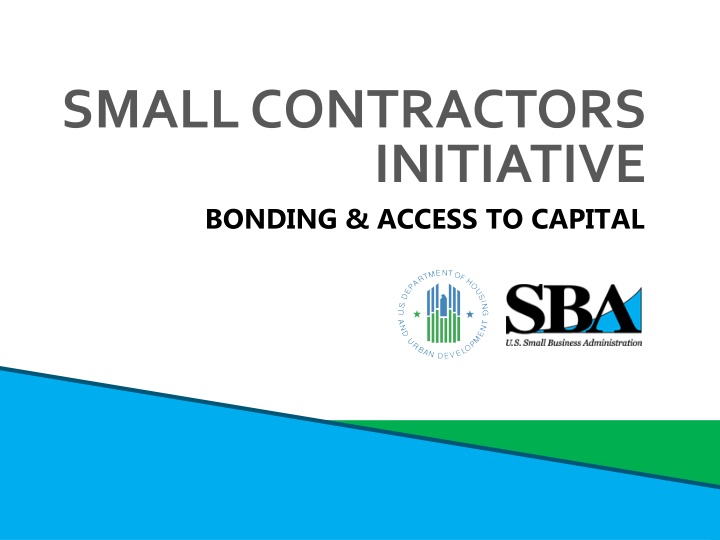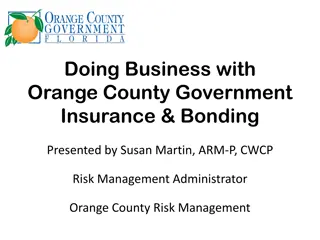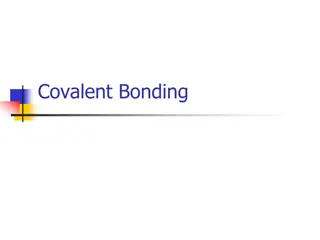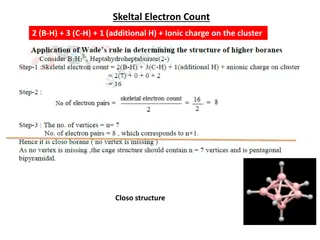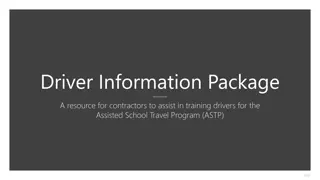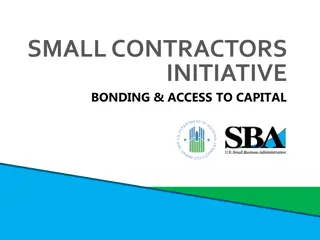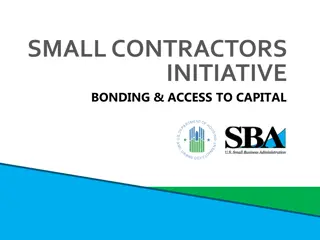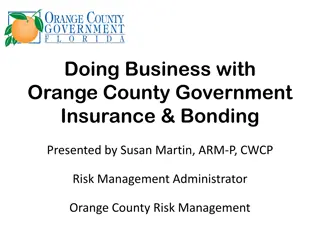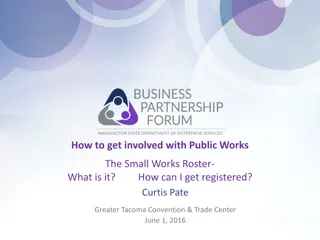Small Contractors Bonding & Access to Capital
Small Contractors Initiative focusing on Bonding & Access to Capital, including contracting opportunities, business partnerships, and learning objectives to help small contractors qualify for federal agency contracts, with details on available work types and contracted services.
Download Presentation

Please find below an Image/Link to download the presentation.
The content on the website is provided AS IS for your information and personal use only. It may not be sold, licensed, or shared on other websites without obtaining consent from the author.If you encounter any issues during the download, it is possible that the publisher has removed the file from their server.
You are allowed to download the files provided on this website for personal or commercial use, subject to the condition that they are used lawfully. All files are the property of their respective owners.
The content on the website is provided AS IS for your information and personal use only. It may not be sold, licensed, or shared on other websites without obtaining consent from the author.
E N D
Presentation Transcript
SMALL CONTRACTORS INITIATIVE BONDING & ACCESS TO CAPITAL
CONTRACTINGOPPORTUNITIES SESSION 6 CONTRACTING OPPORTUNITIES
SESSION OVERVIEW PART A: BUSINESS OPPORTUNITIES Types of Work Available: Contracted Services Procurement Process Finding Opportunities Requirements Preferences and Set-Asides Bonding Requirements Best Opportunities Self-Evaluation Next Steps and Resources PART B: PARTNERING Assessing Needs and Strengths Forming Teams and Partnering Capability Statement Next Steps and Resources U.S. Dept. of Housing and Urban Development U.S. Small Business Administration 3
PART A: BUSINESS OPPORTUNITIES U.S. Dept. of Housing and Urban Development U.S. Small Business Administration 4
PART A: INTRODUCTION Federal agencies present many business opportunities. Session 2 explains the types of work available, when bonding is required, and how small contractors can qualify. Part A focuses on finding opportunities. Part B is about improving your chances of qualifying by forming partnerships. U.S. Dept. of Housing and Urban Development U.S. Small Business Administration 5
PART A: LEARNING OBJECTIVES 1. Become familiar with how Federally funded agencies award contracts. 2. Understand when bonds are necessary. 3. Identify opportunities and competitive advantages. U.S. Dept. of Housing and Urban Development U.S. Small Business Administration 6
WHAT TYPES OF WORK ARE AVAILABLE? HUD and other Federal agencies provide funding for contract awards covering a wide range of activities. Contracts are awarded by agencies as well as their grantees. Local governments (city and county). States. Independent authorities (PHAs). Developers and other entities. U.S. Dept. of Housing and Urban Development U.S. Small Business Administration 7
CONTRACTED SERVICES Possible services include: Construction and rehabilitation of structures (residential, commercial, and industrial uses). Demolition activities. Improvement of public infrastructure. Street and drainage. Sewer/water systems. Recreational facilities. Parks. Operations and maintenance (e.g., public housing). U.S. Dept. of Housing and Urban Development U.S. Small Business Administration 8
PROCUREMENT Construction projects developed with government funding almost always require: Competitive bidding. Bonding. Compliance with labor and other regulations. Preferences or set-asides for certified disadvantaged business. See SBA presentation How to Prepare Government Contract Proposals. U.S. Dept. of Housing and Urban Development U.S. Small Business Administration 9
LEARNING ABOUT OPPORTUNITIES Notification through a variety of means. Public notices: Solicitations and special invitations. USA.gov ListServe notifications from agencies. Open registrations. Qualified listings (e.g., FedBizOps and System for Award Management (SAM)). Trade publications. Note that registration starts with D-U-N-S #. U.S. Dept. of Housing and Urban Development U.S. Small Business Administration 10
QUALIFYING FOR OPPORTUNITIES Professional credentials. Establishing your capacity to work. Meeting basic requirements for each opportunity. Special preferences. Previously mentioned disadvantaged business opportunities. U.S. Dept. of Housing and Urban Development U.S. Small Business Administration 11
TYPES OF PREFERENCES SBA-Certified 8(a) Program Participant. SBA-Certified HUBZone Firm. HUD Section 3. Small Disadvantaged Businesses. Women-Owned Small Businesses. Minority-Owned Small Business. Service-Disabled Veteran-Owned Businesses. Specific Agency Preferences. U.S. Dept. of Housing and Urban Development U.S. Small Business Administration 12
PREFERENCES OR SET-ASIDE Most contracts include preferences for contractors certified in one of the categories on the previous slide. Typically goals or guidelines favor bids showing participation of such certified businesses. In some cases, agencies require that a percentage of contract awards be set-aside for preference categories. Local governments can target Section 3 hiring or require Section 3 business participation. U.S. Dept. of Housing and Urban Development U.S. Small Business Administration 13
MINORITY- AND WOMEN- OWNED BUSINESSES Affirmative requirement to reach out to minority- and women-owned (MBE/WBE) businesses. Applies to agencies, contractors, and subcontractors. Policy of the agency originating the contract applies. Generally includes: Minimum advertising requirements. Use of MBE/WBE local, State, or national databases. Documentation of outreach efforts. U.S. Dept. of Housing and Urban Development U.S. Small Business Administration 14
MBE AND WBE ADVANTAGES Certification increases visibility in market. Name appears in databases. Numerous entry points to certification. SBA 8(a) program assistance. State governments. Resource: SBA Business Types. U.S. Dept. of Housing and Urban Development U.S. Small Business Administration 15
MBE/WBE CERTIFICATION RESOURCES SBA: Women-Owned Small Businesses. EPA: Disadvantaged Business Enterprise Resources and Training. Minority Business Development Agency. U.S. Dept. of Housing and Urban Development U.S. Small Business Administration 16
IF BONDING IS REQUIRED Prime contractor must be bonded for full value of contract (typically the general contractor (GC)). Subcontractors are covered by GC s bond. Single-trade prime contractors must be bonded. Some GC s require their subcontractors to be bonded too. U.S. Dept. of Housing and Urban Development U.S. Small Business Administration 17
BEST OPPORTUNITIES HUD-funded agencies: State/local governments receiving Community Development Block Grants (CDBG) and HOME grants, particularly including: Disaster recovery. Economic development initiatives. Public housing authorities (PHAs) and Indian tribes are provided similar grants and operating funds. Private developers building and renovating housing financed by HUD-funded agency or other Federal agency. U.S. Dept. of Housing and Urban Development U.S. Small Business Administration 18
SELF-EVALUATION Take 10 minutes to review the opportunity checklist (see handout). How can your firm benefit from Federally funded procurements? Report two potential prospects. U.S. Dept. of Housing and Urban Development U.S. Small Business Administration 19
PART A: NEXT STEPS Link session material to action plan elements, as necessary. U.S. Dept. of Housing and Urban Development U.S. Small Business Administration 20
PART B: PARTNERING U.S. Dept. of Housing and Urban Development U.S. Small Business Administration 21
PART B: INTRODUCTION To pursue opportunities, firms must qualify and present an offer. This means forming strong teams or finding strategic partners, plus developing capability statements. Part B of the session examines those strategies. U.S. Dept. of Housing and Urban Development U.S. Small Business Administration 22
PART B: LEARNING OBJECTIVES 1. Assess your firm s capacity. 2. Determine the need for a partner. 3. Understand various partnership structures. 4. Demonstrate your capacity. U.S. Dept. of Housing and Urban Development U.S. Small Business Administration 23
WHAT ARE NEEDS AND STRENGTHS Assessment: 1. Determine what the agency is looking for. 2. Outline capabilities to perform on chosen contract services. 3. Outline capabilities to perform: Construction skilled trades and management. Business and financial management. Financial strength and working capital. Gaps: What capabilities does the firm lack? U.S. Dept. of Housing and Urban Development U.S. Small Business Administration 24
FORMING A TEAM AND ADDING PARTNERS Strategies: Identifying prospective partners: Where can they be found? How to make yourself an attractive partner. Models: Subcontracting. Joint ventures. Forming new corporate entity (e.g., LLC). U.S. Dept. of Housing and Urban Development U.S. Small Business Administration 25
CAPABILITY STATEMENT As part of bid preparation, you must describe capabilities. Written, one-page description of contractor s services and capabilities. Demonstrate enhanced capacity with added partner. U.S. Dept. of Housing and Urban Development U.S. Small Business Administration 26
EXERCISE Take 20 minutes to: Describe the capabilities needed to perform the work. Incorporate a teaming or partnering strategy. Identify incomplete elements for the action plan. After you complete the exercise, we will discuss the possible capabilities and strategies as a group. U.S. Dept. of Housing and Urban Development U.S. Small Business Administration 27
PART B: NEXT STEPS Consider obtaining technical assistance: Procurement Technical Assistance Centers PTAC Federal Agencies. SBA. HUD s Office of Small and Disadvantaged Business Utilization. USA.gov. Contractor mentoring programs. U.S. Dept. of Housing and Urban Development U.S. Small Business Administration 28
RESOURCES These attachments provide more information on partnering: SBA, How to Prepare Government Contract Proposals, 2014. Partnering to Get Work A Partnering Strategies Guide, 2010. U.S. Dept. of Housing and Urban Development U.S. Small Business Administration 29
